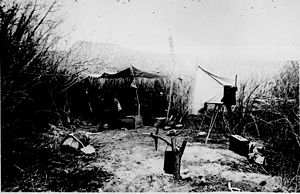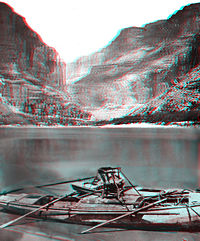Encyclopedia, Difference between revisions of "John Wesley Powell" - New World
m |
John Parker (talk | contribs) (Introduction Completed) |
||
| Line 6: | Line 6: | ||
[[Image:John_powell_camp.jpg|thumb|300px|First camp of the John Wesley Powell expedition, in the willows, Green River, Wyoming, 1871]] | [[Image:John_powell_camp.jpg|thumb|300px|First camp of the John Wesley Powell expedition, in the willows, Green River, Wyoming, 1871]] | ||
| − | ''''''John Wesley Powell'''''' (March 24, 1834 - September 23, 1902) was a [[United States|U.S.]] soldier, [[geology|geologist]], and explorer of the [[American West]]. He | + | ''''''John Wesley Powell'''''' (March 24, 1834 - September 23, 1902) was a [[United States|U.S.]] soldier, [[geology|geologist]], and explorer of the [[American West]]. He earned fame through his [[Powell Geographic Expedition of 1869|Powell Geographic Expedition]], a three-month river trip down the [[Green River (Utah)|Green]] and [[Colorado River (U.S.)|Colorado]] rivers in 1869, that included the first known passage through the [[Grand Canyon]]. Powell retraced his first route in 1871-1872, this time producing historic photographs, an accurate map, and scientific publications. |
| + | |||
==Life== | ==Life== | ||
Revision as of 13:38, 28 December 2006
'John Wesley Powell' (March 24, 1834 - September 23, 1902) was a U.S. soldier, geologist, and explorer of the American West. He earned fame through his Powell Geographic Expedition, a three-month river trip down the Green and Colorado rivers in 1869, that included the first known passage through the Grand Canyon. Powell retraced his first route in 1871-1872, this time producing historic photographs, an accurate map, and scientific publications.
Life
Powell was born in Mount Morris, New York, the son of Joseph and Mary Powell. His father, a poor itinerant preacher, had emigrated to the US from Shrewsbury, England in 1830. His family moved westward to Chillicothe, Ohio, Walworth County, Wisconsin, and then finally settled in rural Boone County, Illinois. He studied at Illinois College, Wheaton College, and Oberlin College, acquiring a knowledge of Ancient Greek and Latin, but never graduated. Powell also had a deep interest in the natural sciences. As a young man, he undertook a series of adventures through the Mississippi River valley, exploring and collecting shells & minerals. In 1855 he spent four months walking across Wisconsin. In 1856 he rowed the Mississippi River from St. Anthony to the sea. In 1857 he rowed down the Ohio River from Pittsburgh to St. Louis. Finally, in 1858 he rowed down the Illinois River and then up the Mississippi and the Des Moines rivers to central Iowa. As a young man Powell also studied botany, zoology, and geology on his own, without having a teacher to guide him. His explorations, collections, and knowledge of the natural sciences led to his election as secretary of the Illinois Natural History Society in 1859.
During the Civil War, he enlisted in the Union Army, serving first with the 20th Illinois Volunteers. At the Battle of Shiloh, he lost most of one arm when struck by a musket ball. The raw nerve endings in his arm would continue to cause him pain the rest of this life. Despite the loss of an arm, he returned to the army and was present at Champion Hill and Big Black River Bridge. Further medical attention to his arm did little to slow him down; he was made a major and served as chief of artillery with the 17th Army Corps. In 1862 he married Emma Dean.
After leaving the Army he took the post of professor of geology at the Illinois Wesleyan University. He also lectured at Illinois Normal University, helping found the Illinois Museum of Natural History, where he served as the curator, but declined a permanent appointment in favor of exploration of the American West.
In 1881 he became the second director of the US Geological Survey, a post he held until he voluntarily retired in 1894. He was also the director of the Bureau of Ethnology at the Smithsonian Institution until his death in 1902. Powell was buried in Arlington National Cemetery.
Work
As an ethnologist and early anthropologist, Powell subscribed to a particularly rigid form of cultural evolutionary theory. In his writings, he divided all societies into "Savages," "Barbarians," and "Civilizations." For the savages, Powell clearly had in mind the Native Americans he encountered in his travels; for the barbarians he probably was thinking of the Huns and other European chiefdoms that had conquered Rome in antiquity. By civilization, Powell clearly had his own society in mind. In his view, all societies naturally progressed toward civilization; those who had not achieved industrialization had not fulfilled their potential.
From 1867 he led a series of expeditions into the Rocky Mountains and around the Green and Colorado rivers. In 1869 he set out to explore the Colorado and the Grand Canyon. He gathered nine men, four boats and food for ten months and set out from Green River, Wyoming on May 24. Passing through dangerous rapids, the group passed down the Green River to its confluence with the Colorado River (then also known as the Grand River upriver from the junction), near present-day Moab, Utah. The expedition's route traveled through the Utah canyons of the Colorado River, which Powell described in his published diary as having ...wonderful features — carved walls, royal arches, glens, alcove gulches, mounds and monuments. From which of these features shall we select a name? We decide to call it Glen Canyon. One man quit after the first month and another three in the third, only days (two to be exact) before the group reached the mouth of the Virgin River on August 30, after traversing almost 1,500 km. The three who left the group late in the trip were later killed; exactly how and why they died remains a mystery debated by Powell biographers. After returning to Illinois as a hero, Powell lectured and raised money for a second expedition. Powell retraced his first route in 1871-1872, this time producing photographs, an accurate map, and scientific publications.
Legacy
John Wesley Powell is remembered for his expeditions to explore and map the Colorado River and its canyons. Thorough his explorations, Powell confirmed his theory that the Colorado River existed prior to the Grand Canyon, which cut out the canyons as the Colorado Plateau rose.
Powell and his crew are most likely the first Caucasians to have successfully traveled down the Colorado River.
In 1895 Powell published a book based on his explorations of the Colorado originally titled Canyons of the Colorado, now known as The exploration of the Colorado River and its canyons.
Lake Powell, a huge reservoir formed by the construction of the Glen Canyon Dam in Utah, is named after him.
The John Wesley Powell Memorial Museum is located along the Colorado River in Page, Arizona, the site of the Glen Canyon Dam, near the border of Arizona and Utah.
Publications
- Powell, John Wesley. Canyons of the Colorado. Flood & Vincent, 1895.
- Powell, John Wesley. The Exploration of the Colorado River and its Canyons. New York: Dover Press. ISBN 0486200949
- Powell, John Wesley. Down The Colorado: Diary of the First Trip through the Grand Canyon, 1869;:Photographs and Epilogue, 1969. Allen & Unwin, 1969 ISBN 004917004X
- Powell, John Wesley. The Hopi Villages (The Ancient Province of Tusayan). Filter Press, 1999. ISBN 0910584737
- Powell, John Wesley. The Diary of John Wesley Powell (In My Own Words). New York: Benchmark Books, 2000. ISBN 0761410139
ReferencesISBN links support NWE through referral fees
- Dolnick, Edward. (2002). Down the Great Unknown : John Wesley Powell's 1869 Journey of Discovery and Tragedy Through the Grand Canyon (Paperback). Harper Perennial. ISBN 0-06-095586-4.
- Dolnick, Edward (2001). Down the Great Unknown : John Wesley Powell's 1869 Journey of Discovery and Tragedy Through the Grand Canyon (Hardcover). HarperCollins Publishers. ISBN 0-06-019619-X.
- Worster, Donald (2000). A River Running West: The Life of John Wesley Powell. Oxford University Press. ISBN 0-19-509991-5.
- Reisner, Marc (1993). Cadillac Desert: The American West and Its Disappearing Water (Paperback). Penguin Books. ISBN 0-14-017824-4.
- Wallace Earle Stegner (1982). Beyond the Hundredth Meridian: John Wesley Powell and the Second Opening of the West. University of Nebraska Press. ISBN 0-8032-4133-X
- National Geographic Society (US) Book division (1999) Exploring the Great Rivers of North America. ISBN 0-7922-7846-1.
- John Wesley Powell Memorial Museum (http://powellmuseum.org/MajorPowell.html) 12/22/2006
External links
- NPS John Wesley Powell Photograph Index
- Works by John Wesley Powell. Project Gutenberg
Credits
New World Encyclopedia writers and editors rewrote and completed the Wikipedia article in accordance with New World Encyclopedia standards. This article abides by terms of the Creative Commons CC-by-sa 3.0 License (CC-by-sa), which may be used and disseminated with proper attribution. Credit is due under the terms of this license that can reference both the New World Encyclopedia contributors and the selfless volunteer contributors of the Wikimedia Foundation. To cite this article click here for a list of acceptable citing formats.The history of earlier contributions by wikipedians is accessible to researchers here:
The history of this article since it was imported to New World Encyclopedia:
Note: Some restrictions may apply to use of individual images which are separately licensed.

